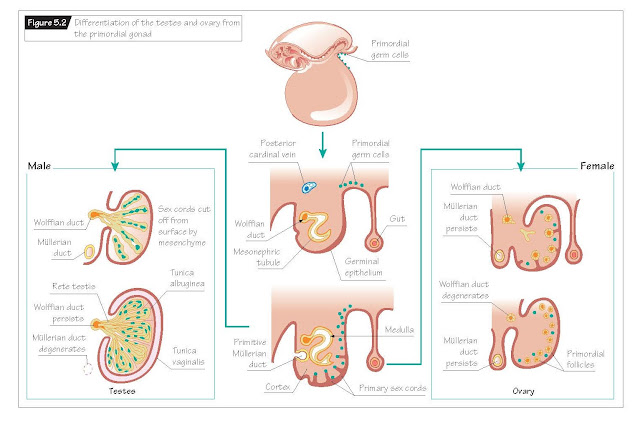Gonadal Development In The Embryo
All mammalian females are
homogametic and represent the “default” pathway in sexual differentiation.
Homogametic describes the sex whose cell nuclei contain two similar sex
chromosomes. While this characterizes mammalian females, the homogametic sex is
male in butterflies, birds and some amphibians and fishes. In humans, all
normal oocytes from genetic females will carry 22 autosomes and an X chromosome
(22X). Mammalian embryos of both genetic sexes are bathed in relatively large
amounts of placental estrogen during development. In the absence of specific
factors regulated by a single gene on the Y chromosome, embryos will develop
into a female phenotype. The human female, like all mammalian females,
represents the fundamental or undifferentiated phenotypic sex.
All mammalian males are
heterogametic. They produce gametes with both 22X and 22Y chromosome
complements. Males are considered the differentiated phenotypic sex. With few exceptions,
any individual that carries a specific piece of the Y chromosome will develop a
testis and a male phenotype. This segment of the Y chromosome has been called
the sex-determining region of the Y chromosome (SRY) (Fig. 5.1).
Specific instruction from the SRY region of the Y chromosome directs the
undifferentiated gonad to become a testis. Without the presence of SRY, a
fetus will develop along the default or female phenotypic pathway.
The Y chromosome is much smaller
than the X and very little of its DNA is available for RNA synthesis. Many of
the genes that control testicular development from the undifferentiated gonad
are therefore located on other chromosomes, including autosomes and the X chromosome.
However, the Y chromosomecontains a specific, single-copy gene that determines
testicular differentiation. This gene is located on the short arm of the
chromosome within SRY and appears to activate genes on other chromosomes.
Evidence for the importance of
SRY comes from both clinical and experimental research results. Examination of
the DNA sequences of women with XY karyotypes has revealed that a single locus
within the Y chromosome must be present and intact for an individual to have a
testis. Absence of, or damage to, this DNA sequence in individuals with an
otherwise intact 46XY male chromosomal content results in ovarian development
and a phenotypic female. Likewise, examination of the DNA sequences of
phenotypic men with XX karyotypes will reveal the aberrant presence of SRY
sequences.
Gonadal differentiation
Gonadal development begins in the
human at the 4th embryonic (6th menstrual) week in parallel with the formation
of the ventral body wall. The first step in gonadal development is the
migration of undif- ferentiated primordial germ cells from their site of
formation in the yolk sac. These germ cells arise from the endoderm lining the
yolk sac; they detach themselves and migrate dorsally along the yolk stalk,
midgut and dorsal mesentery to reach the genital ridges. The genital ridges lie
on the medial aspect of the mesonephric ridge that will contribute to the
developing kidney. Over the next 2 weeks the primordial germ cells mitose
repeatedly, forming a vast population of precursor gametes. Failure of these
germ cells to develop and populate the genital ridges at this time will result
in complete failure of gonadal formation.
When germ cells reach the
coelomic epithelium lining the genital ridge, cellular contact causes the
coelomic epithelia to differentiate into a primitive germinal epithelium. The
germ cells become embedded in the primitive germinal epithelium during this
process of differentiation. This combination of germinal epithelia and germ
cells forms the sex cords. The connection of the sex cords to the coelomic wall
(gonadal surface) is maintained at this point. The gonads are now
histologically distinct, bipotent organs that may become testes or ovaries (Fig. 5.2). Inappropriate or
incomplete developmental signals during this stage can result in the rare
condition of hermaphroditism. True hermaphrodites have both ovaries and testes
and are extremely rare in humans.
In a genetic male, gene products
directed by activation of the SRY locus on the Y chromosome now cause the
undifferentiated sex cords to enlarge, split and begin to form the primitive
testis. Subepithelial mesenchyme arises between the germinal epithelium and
the sex cords and cuts the cords off from the gonadal surface. The sex cords
are now housed within the inner portion of the gonad – the testicular
medulla. The primordial germ cells within the sex cords begin to
differentiate into immature sperm cells called spermatogonia. The
supporting sex cord cells form precursor Sertoli cells.
Ovarian differentiation occurs
about 2 weeks later than testicular development. Initially, the sex cords of
the developing ovary continue to proliferate while maintaining their connection
with the gonadal surface. The germ cells begin to differentiate into primordial
oocytes called oogonia within follicles. The epithelium surrounding the
oogonia differentiates into granulosa cells. Subepithelial mesenchyme
then invades the gonad and breaks up the sex cords, isolating the follicles. This mesenchyme will become
the ovarian stroma. Unlike the testis, developing ovarian gametes are now housed
in the outer portion of the gonad–the ovarian cortex.
The ovary and testes can be
histologically distinguished from each other by the 8th embryonic (10th
menstrual) week of pregnancy. The progeny of the germinal epithelium are now
apparent as Sertoli cells in the male and granulosa cells in the female.
Similarities between males and females in the endocrine function of these cells
stem from their common ancestry. The mesenchyme arising beneath the germinal
epithelium in the testis is the anlagen of testicular interstitial cells, also
known as Leydig cells. The mesenchyme arising beneath the germinal
epithelium of the ovary is the anlagen of ovarian stroma or thecal cells.
Functional similarities in these two cell types will also be seen in the mature
glands.
Once the undifferentiated gonads
begin to develop into either ovaries or testes, the remainder of sexual
differentiation is dependent on secretory products of the testes only. In the
absence of these specific testicular secretions, the phenotype that develops is
completely female. The ovary and its secretory products do not contribute to
the development of the uterus, fallopian tubes, vagina or vulva.






